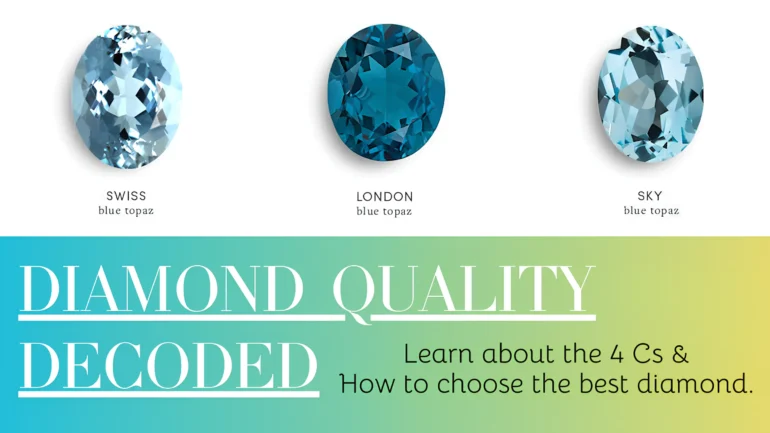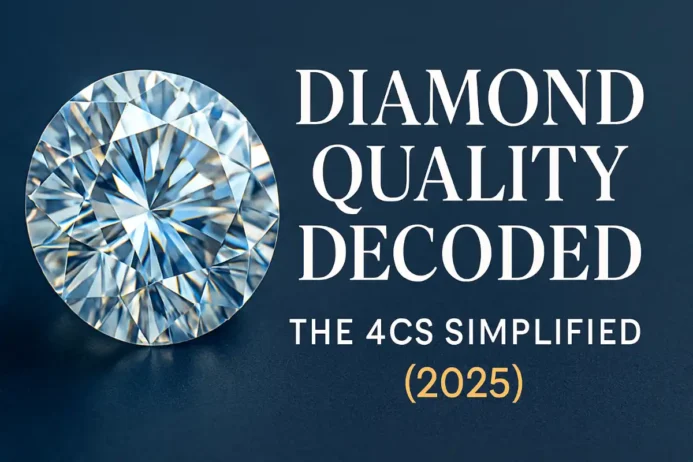🕒 Last Updated on September 21, 2025, 4:30 PM EDT
Diamonds are treasured for their brilliance, beauty, and symbolism—but not all diamonds are created equal. If you’re shopping for an engagement ring, anniversary gift, or want to invest in smart jewelry, understanding the “Four Cs” of diamond quality is essential for making an informed and confident choice in the US market.
🎁 Want 100+ more gift ideas for FREE ? Check out our Ultimate Jewelry Gift Ideas (Updated 2025) — perfect for every style, occasion, and budget.
Introduction
Choosing a diamond can feel overwhelming—especially when every guide sounds technical and complex. But it doesn’t have to be. In 2025, the 4Cs of Diamonds—Cut, Color, Clarity, and Carat—remain the trusted standard, hands-on for decoding quality. In this guide, you’ll not only understand what each “C” means but how to apply them smartly based on your preferences, budget, and value. Let’s dive in.
1. Cut: Where Brilliance Begins
Cut is how well a diamond is fashioned—it determines how brilliantly it sparkles, far more than color or clarity. A poor cut sends light escaping; an excellent cut makes diamonds dance with light. Choose cuts graded Excellent to Very Good for maximum brilliance—even in lower color or clarity grades.
2. Color: Subtle, But Savvy
Diamond color refers not to rainbow hues, but to the amount of tint in white diamonds—from D (colorless) to Z (yellowish). Most people can’t detect differences between D to H with the naked eye. A G–H diamond in a white gold setting can look nearly identical to D, while saving significantly on budget.
3. Clarity: Imperfections Are Natural
Clarity measures internal/external marks called inclusions or blemishes. Ratings range from FL (Flawless) to I3 (Included). Many diamonds in VS1–SI1 offer eye-clean clarity—meaning no visible flaws without magnification—offering the best price-to-look value.
4. Carat: Size vs. Substance
Carat is the diamond’s weight (1 carat = 0.2 grams). Remember: two diamonds with the same carat weight can look different in size depending on cut proportions. A well-cut smaller diamond can look larger than a heavier, poorly cut one. Prioritize cut over carat for brilliance and visual impact.
Smart Prioritization: What to Focus On

- Cut – Always top priority for sparkle
- Color – D to H is visibly similar; choose based on setting
- Clarity – Go for eye-clean vs. perfection
- Carat – Balance size with smart budgeting
Your Quick Decision Guide
| Diamond Feature | Premium Choice | Smart Middle | Budget-Friendly |
|---|---|---|---|
| Cut | Excellent | Very Good | Good |
| Color | D–F (colorless) | G–H (near colorless, looks same to eye) | I–J (slightly warm but affordable) |
| Clarity | VVS1–VS1 (very few inclusions) | VS2–SI1 (eye-clean) | SI2+ (inclusions may be visible) |
| Carat | Higher carat weight | Balanced size with good cut | Slightly smaller but saves cost |
| Visual Impact | Exceptional sparkle + “perfect” look | Sparkle + size balance, looks premium | Looks good in right setting |
| Best For | Luxury buyers, collectors | Most engagement ring shoppers | Budget-conscious, practical buyers |
FAQs
u003cstrongu003eWhich ‘C’ matters most?u003c/strongu003e
Cut tops all—it’s the secret to sparkle.
u003cstrongu003eCan I skip a certificate?u003c/strongu003e
Never. Always choose diamonds graded by trusted labs like GIA or AGS.
u003cstrongu003eIs a bigger carat always better?u003c/strongu003e
A great cut in a smaller carat can appear more dazzling than a dull larger stone.
u003cstrongu003eAre SI1 diamonds a bad choice?u003c/strongu003e
Not if they’re eye-clean. Many SI1 diamonds look flawless to the unaided eye.
u003cstrongu003eDoes diamond shape impact the Cs?u003c/strongu003e
Subtly. For elongated shapes (emerald, oval), clarity and color become more visible.
External Sources:
- GIA’s official 4Cs explanation — the industry standard on diamond grading GIA 4Cs
- American Gem Society’s 4Cs breakdown — trusted insights on diamond value factors American Gem Society
- Natural Diamonds on Clarity importance — expert perspective on clarity and rarity Only Natural Diamonds
- Natural Diamonds on 4Cs and visual decision-making — how cut trumps other Cs for visual impact Only Natural Diamonds

